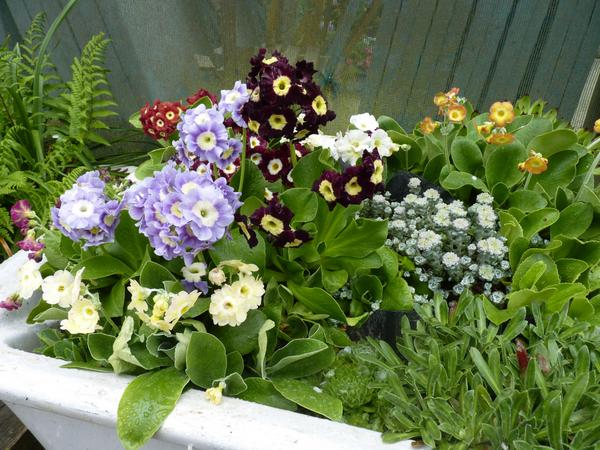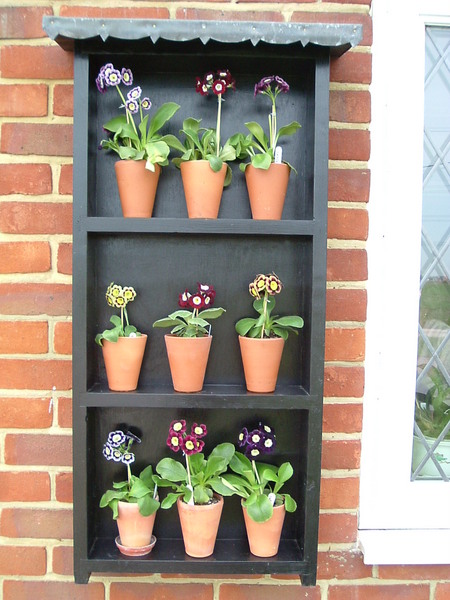Growing auricula
Barnhaven Border Auriculas
Our auriculas are raised to be hardy and to survive without the special cossetting that is sometimes required by show auriculas. They grow well in a normal soil, either in pots, troughs or in a well-drained border or rockery. The main thing is to make sure the soil is well-drained and that they are in a semi-shady spot.
 Auriculas growing in an old ceramic sink with saxifraga.
Auriculas growing in an old ceramic sink with saxifraga.
If your soil is heavy, add some small gravel and a gravel mulch around the plant will help to avoid rot if the winter is wet. It also seems to deter slugs and the dreaded vine weevil. Try to remove dead leaves which fall on your plants. For the best flowers, give a low dose of tomato feed every week as soon as you see new buds, until full flowering. We would suggest dividing them every couple of years and enriching the soil with well-rotted manure or compost when you replant them. We do not recommend covering the plants in winter. They are hardy alpine plants that are used to being under a layer of snow in the winter.
Alpine and double auriculas are also not very fussy plants and can be grown as above.
Show Auriculas
To safeguard the spectacular beauty of the Show auriculas (Selfs, Fancies and Edges). it is often usual to keep them in pots either in a well ventilated and shaded alpine house, or in pots with some sort of protection outdoors in the winter for example an outdoor veranda, or on a north-facing window ledge. They don't mind the cold, only excessive wet and the rain on the flowers can wash the farina away. Often displayed in 'theatres' or shelving units in the spring they will make lovely show and can be moved to a less prominent and shady place in the summer months.
© Colin Humphrey, National Auricula and Primula Society Kent group.
Here is a brief summary of our own Show auricula year :
Spring - we start to water the plants little by little as the weather begins to warm up, keeping them just moist. As the buds appear we begin to give a small amount of tomato fertiliser, until flowering.
Late spring - after the flowers have finished we re-pot into fresh compost*. If there are rooted offsets we remove them carefully and pot them on into small pots. It’s important not to give your auriculas too large a pot. They do seem to like their roots a bit constrained. We then put the pots into the shade and keep them just moist. This can also be done in the autumn, depending on your local conditions. See the page on Dividing Primula for more information.
Summer: Do not overwater. Leave the pots to dry out in between watering. If the weather is very hot and dry, watch out for spider-mite (tiny red insects that leave spider-like webs on the underside of leaves). This can avoided by misting the leaves during very dry periods. Treat if need be or import predatory mites that feed on them. .
Autumn and winter – not a great deal to do apart from keeping them just damp enough to stay alive. You do not need to worry about frost; auriculas are fully hardy to -20°C.
All year - Removing dead leaves and stems that come away easily does help to avoid rot. Keep an eye out for green fly, and root aphid. The root aphid appears as white fluffy insects around the roots of the plants and the neck. See our page on Pests and diseases for more information.
* Compost: each grower has his own recipe but the emphasis has to be on good drainage. We use a mixture of a very open peat based compost, mixed with vermiculite and gravel.

